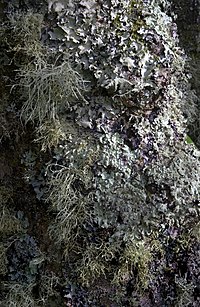
Photo from wikipedia
The genus Omphalina is an ideal genus for studying the evolutionary mechanism of lichenization. Based on molecular phylogeny using ITS and nuLSU sequences by means of Bayesian and maximum likelihood… Click to show full abstract
The genus Omphalina is an ideal genus for studying the evolutionary mechanism of lichenization. Based on molecular phylogeny using ITS and nuLSU sequences by means of Bayesian and maximum likelihood analyses and morphological examination, combining the existence of green algae in basidiomata stipe and a Botrydina-type vegetative thallus, we described a bryophilous new basidiolichen species, Omphalina licheniformis, from a residential area of Jiangxi Province, China. This finding of unusual new basidiolichen species updated our understanding of the delimitation of Omphalina, indicating that both non-lichen-forming and lichen-forming fungal species are included simultaneously. The presence of algal cells in the basidiomata should receive more attention, as this would be helpful to distinguish more potential basidiolichens and explore the cryptic species diversity. This work provides new insights and evidence for understanding the significance of lichenization during the evolution of Agaricomycetes.
Journal Title: Journal of Fungi
Year Published: 2022
Link to full text (if available)
Share on Social Media: Sign Up to like & get
recommendations!